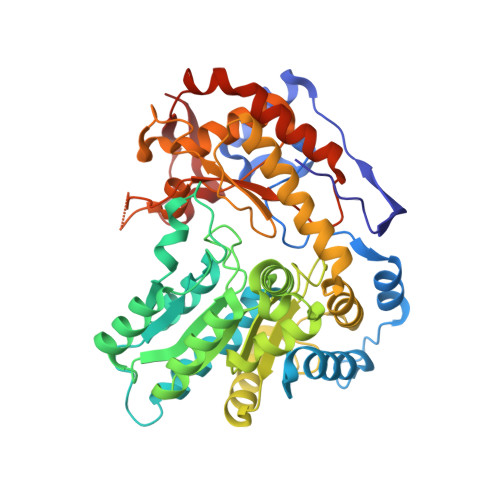Structure and dynamics of Proteus vulgaris tryptophan indole-lyase complexes with l-ethionine and l-alanine.
Phillips, R.S., Brown, S.M.(2025) Arch Biochem Biophys 768: 110402-110402
- PubMed: 40147499
- DOI: https://doi.org/10.1016/j.abb.2025.110402
- Primary Citation of Related Structures:
8V2K, 8V4A, 9DY7 - PubMed Abstract:
Tryptophan indole-lyase (TIL; [E.C. 4.1.99.1]) is a pyridoxal-5'-phosphate (PLP) dependent enzyme that catalyzes the reversible ¦Â-elimination of indole from l-tryptophan. l-Alanine and l-ethionine are TIL competitive inhibitors that form stable quinonoid complexes with ¦Ë max ¡«508?nm. We have now determined the X-ray crystal structure of the tetrameric TIL complexes with l-alanine and l-ethionine, with either K + or Na + in the cation binding site. For the K + -form, the structures show a mixture of external aldimine and quinonoid complexes, with both open and closed active site conformations. However, the Na + -form exhibits noncovalent and external aldimine complexes in only open active site conformations. Stopped-flow kinetics of l-ethionine binding show that the Na + -form of TIL reacts much more slowly than the K + -form. The l-alanine and l-ethionine complexes of TIL are affected by hydrostatic pressure, suggesting that solvation contributes to the reaction. As pressure increases, the peak at 508?nm decreases, and a new peak at 344?nm appears. These changes are reversible when pressure is released. The 344?nm species could be either a gem-diamine or an enolimine tautomer of the external aldimine. We measured the fluorescence spectrum of the complex under pressure to differentiate these structures. When excited at either 290 or 325?nm, the complex emits at 400?nm, establishing that it is a gem-diamine complex. This peak does not form when the Na + -form of TIL complexed with l-ethionine is subjected to high pressure. Pressure jumps for the TIL-K + -l-ethionine complex measured at 508?nm result in pressure dependent relaxation rate constants. The relaxations show a large activation volume in the direction of quinonoid intermediate formation, suggesting that it is coupled with a conformational change. These results provide new insights into the dynamics of ligand binding to TIL.
Organizational Affiliation:
Department of Chemistry, University of Georgia, Athens, GA, 30602, USA; Department of Biochemistry and Molecular Biology, University of Georgia, Athens, GA, 30602, USA. Electronic address: plp@uga.edu.




















